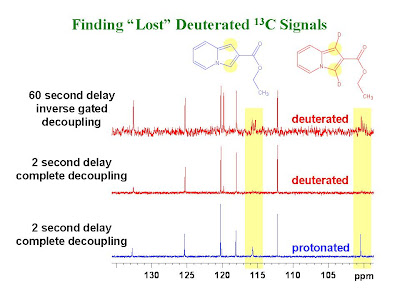Several times a year I will get a question like, "I just deuterated my compound and now I can't see the 13C NMR signals for the deuterated carbons - why not?" There are at least three reasons why seeing these signals may be difficult. First of all, the principal relaxation mechanism for protonated carbons is the dipolar interaction between the 13C and the attached protons. When the protons are replaced by deuterium the dipolar mechanism for relaxation is much less efficient and the T1 for the deuterated carbon may be more than an order of magnitude greater than that of the comparable protonated carbon. The long T1 for the deuterated carbon may mean that it will be saturated when using the "standard parameters" and either not show up or be of much reduced intensity. Secondly, the intensity of the carbon signal will be split into a multiplet due to 13C - 2H J coupling depending on how many deuterons are attached to the carbon (1:1:1 triplet for CD, 1:2:3:2:1 pentet for CD2 and 1:3:6:7:6:3:1 septet for CD3). This means that the intensity of the proton decoupled CHn singlet will be spread over all of the lines of the 13C - 2H J multiplet with a corresponding large decrease in signal-to-noise ratio for any one of the lines of the multiplet compared to the proton decoupled singlet for the CHn carbon. Thirdly, there is almost no nuclear Overhauser enhacement for deuterated carbons as there are no directly bound protons. This means that if proton decoupling is applied both during the acquisition and the recycle delay, the protonated carbon signals will grow at a much faster rate than the deuterated carbon signals as the number of scans is increased. In the figure below is an example. The lower panel shows the partial spectrum of a protonated organic molecule using proton decoupling during both the acquisition time and the 2 second recycle delay. The middle panel shows the similar spectrum of a partially deuterated molecule. Note that the deuterated carbon signals are "lost". The top panel shows a spectrum acquired with the same number of scans as that in the middle panel but with a 60 second recycle delay and decoupling only during the acquisition time (i.e. not during the recycle delay). Acquirng the data in this way eliminates the problems of long relaxation times and differential nOe's. In this spectrum one can see the deuterated carbon signals however the signal-to-noise ratio is lower than those for the protonated carbons due to the splitting from 13C - 2H J coupling. In this particular case also, a further loss in signal-to-noise ratio results because the nitrogen bearing carbon is also broadened due to partial self decoupling of the 14N from the 13C.
Bottom line - collect your data over a long period of time with a long recycle delay and inverse gated proton decoupling.

By Glenn Facey of University of Ottawa




